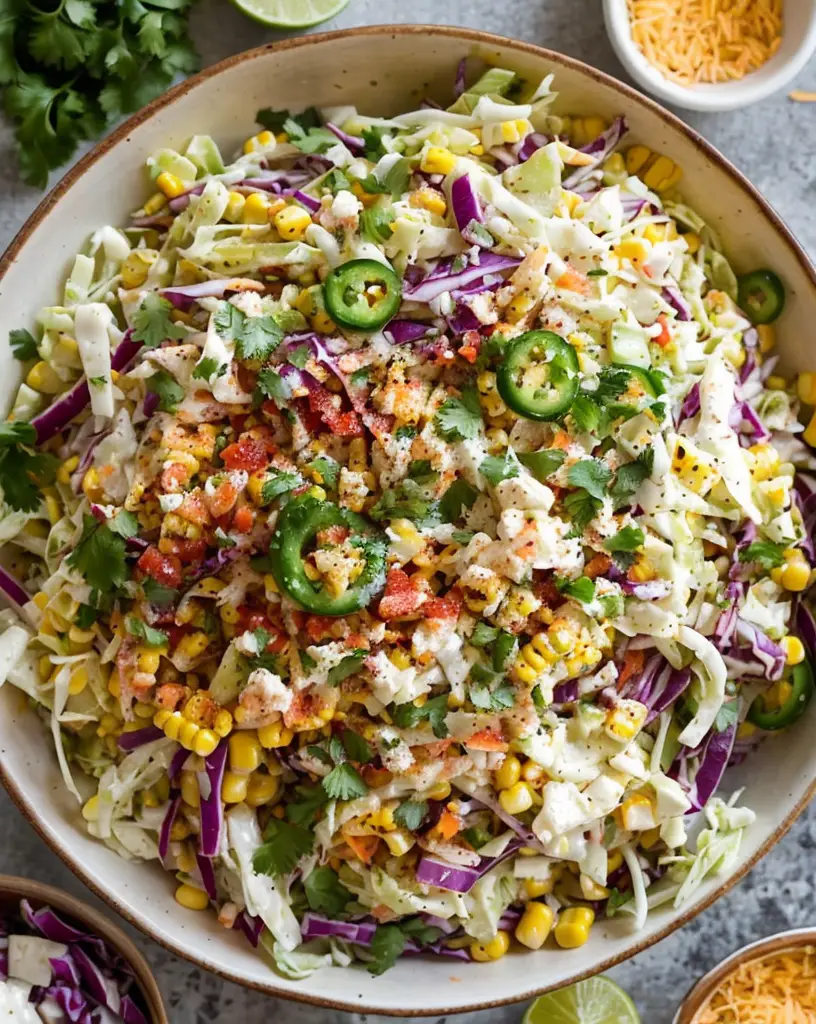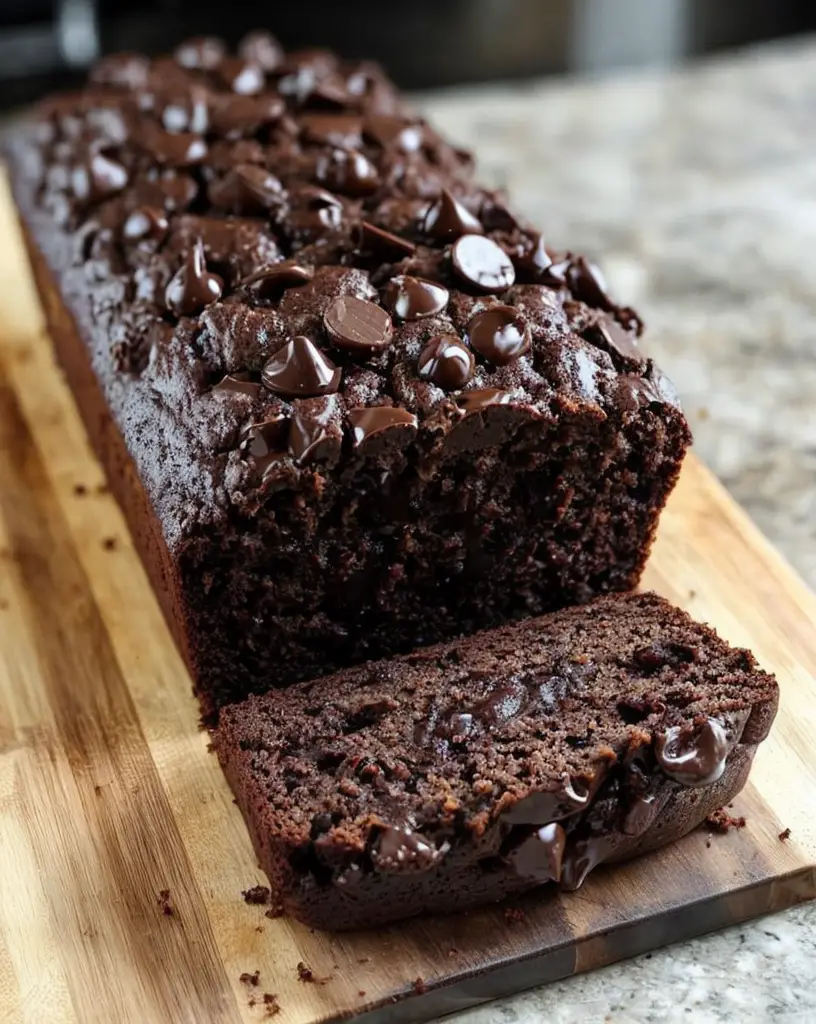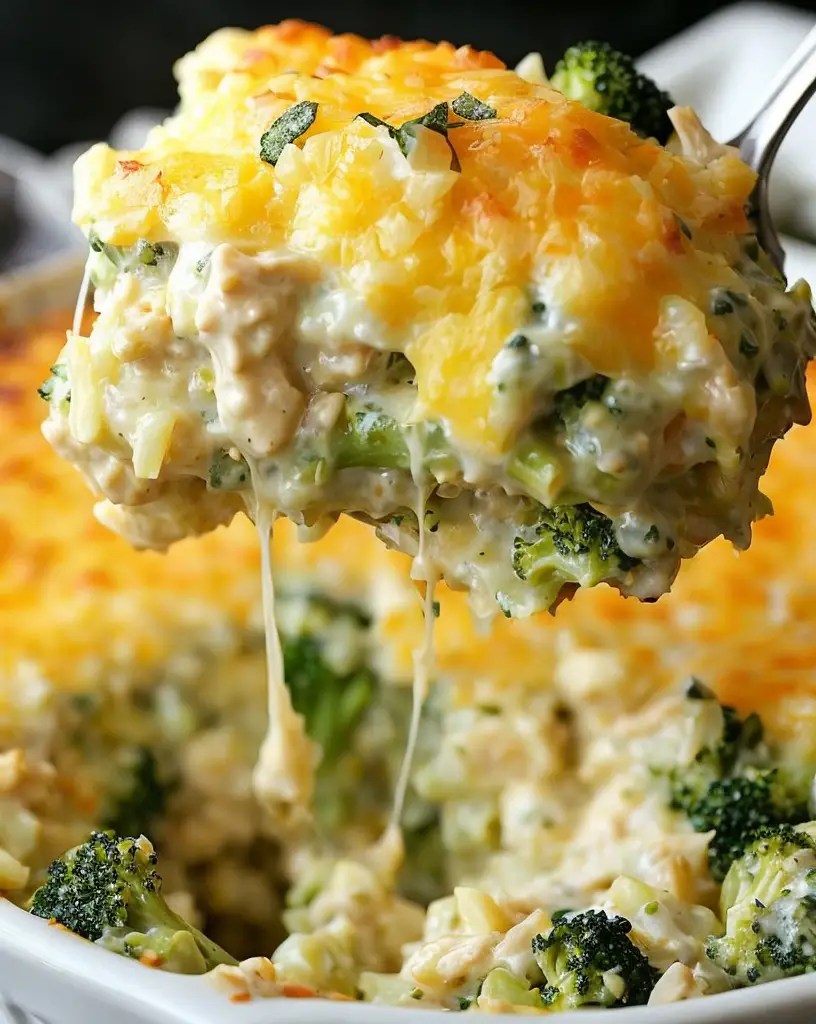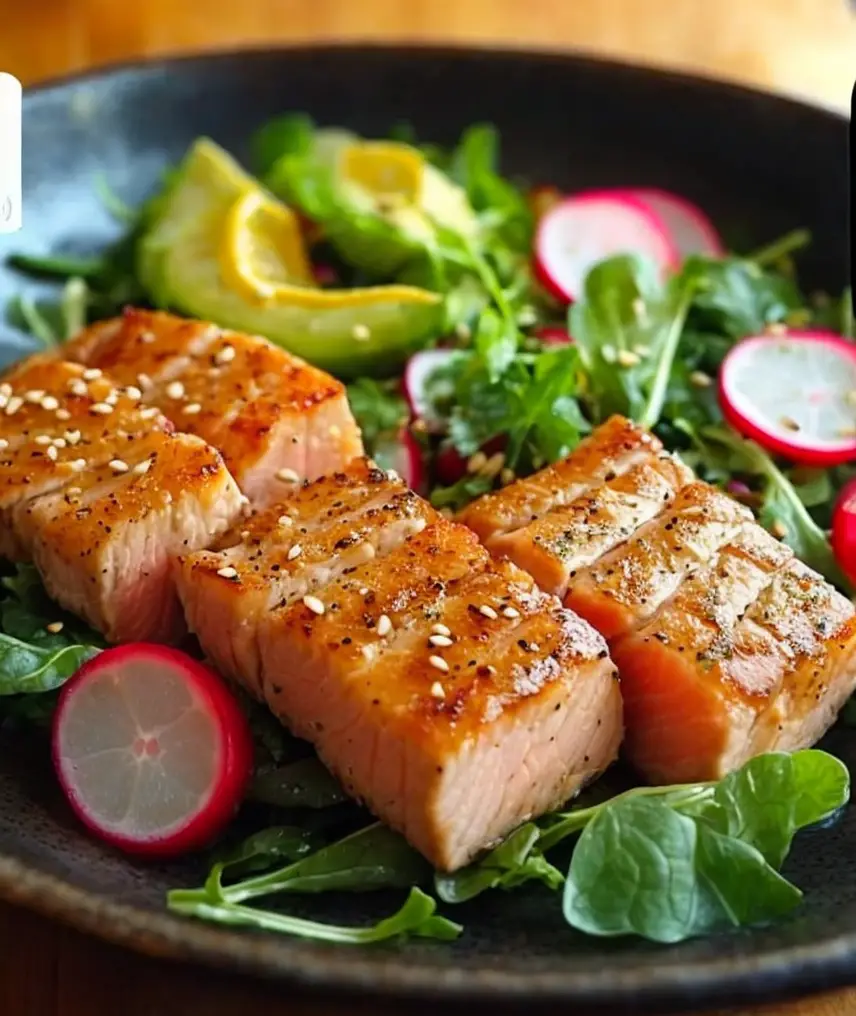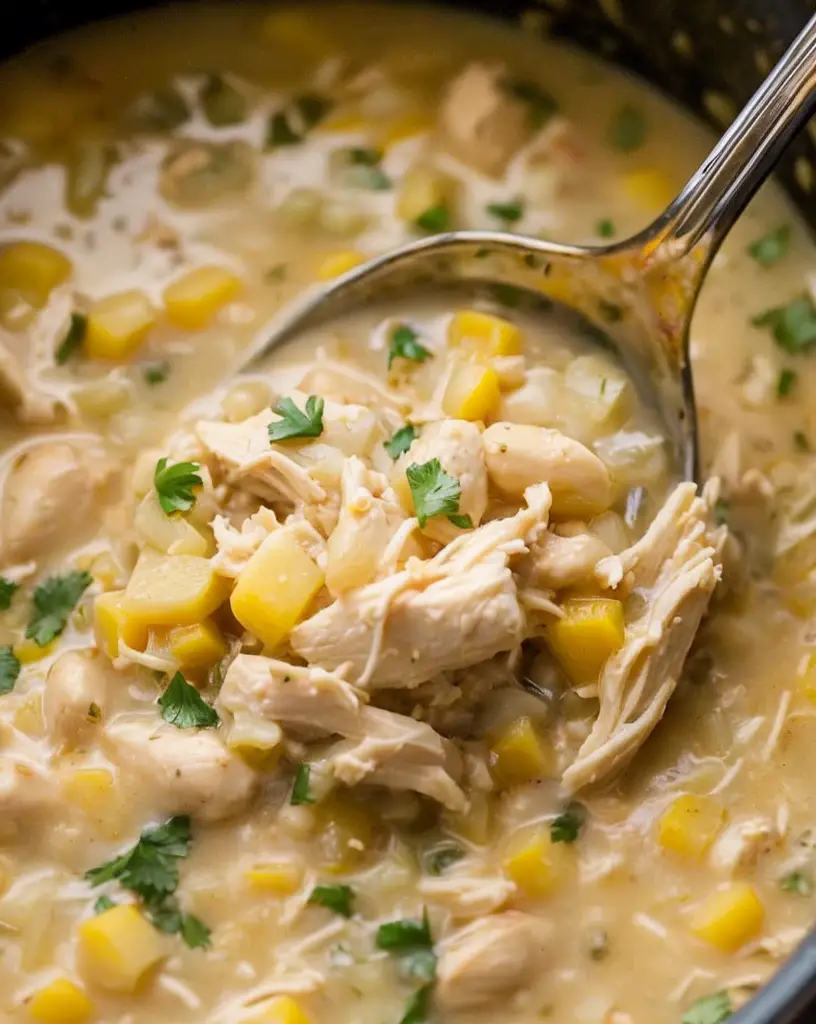Mexican-Style Corn Coleslaw: A Fusion of Fresh Flavors
Get ready to transform your summer gatherings with a vibrant, zesty Mexican-Style Corn Coleslaw that will steal the spotlight at any meal. This dish combines the savory sweetness of fresh corn with the tangy crunch of coleslaw, creating an irresistible blend of flavors and textures. A sprinkle of cilantro and a kick from jalapeños take this dish to a new level, ensuring your taste buds are in for a treat.
Picture this: sun-soaked backyard barbecues or lazy Sunday brunches. That’s the perfect setting for this refreshing Mexican-Style Corn Coleslaw. The colors alone will make your eyes dance, while the aroma will draw everyone to the table before you even have a chance to call them. Whether you’re serving it beside juicy grilled chicken or piling it high in a taco, this coleslaw is the perfect companion.
Quick Recipe Highlights
- Flavor Profile: The coleslaw combines sweetness from the corn, tanginess from lime, and a hint of heat from jalapeños.
- Texture: A crisp bite from the cabbage pairs beautifully with the tender crunch of fresh corn.
- Aroma: The fresh scent of cilantro mingles with the earthy, roasted corn notes.
- Visual Appeal: Bright yellow corn, purple cabbage, and green jalapeños create a fiesta of colors.
- Skill Level Needed: Simple chopping skills and basic mixing are all you need.
- Special Equipment: A sharp knife, cutting board, and a large mixing bowl are essential.
Recipe Overview
- Difficulty Level: This easy-to-follow recipe is suitable for beginners and seasoned cooks alike, requiring only basic culinary skills.
- Category: Versatile as both a side dish and a standalone meal component.
- Cuisine: Mexican-inspired, bringing traditional flavors in a contemporary form.
- Cost: Budget-friendly as it utilizes cost-effective, readily available ingredients.
- Season: Ideal for summer when corn is freshest, but enjoyable year-round with canned versions.
- Occasion: Perfect for casual get-togethers or picnics, offering a refreshing complement to various dishes.
Why You’ll Love This Recipe
Indulge in the taste and texture of Mexican-Style Corn Coleslaw, where each bite brings a delightful mix of sweet, savory, and spicy elements. The corn provides a natural sweetness that contrasts beautifully with the tangy cabbage and lime, creating a symphony of flavors. The crispness of the cabbage provides a satisfying crunch, and the silkiness of the mayo-based dressing coats your palate in the most pleasant way.
Convenience is another reason to love this recipe. With just a few ingredients and minimal prep time, this coleslaw is quick to prepare, making it an ideal choice for those busy weeknight dinners or spontaneous summer parties. It’s easy to scale the recipe up or down based on your serving needs, allowing it to adapt to any occasion effortlessly.
Nutritionally, this dish offers fiber and vitamins from the fresh vegetables, while being low in carbohydrates and saturated fats. It’s an excellent way to incorporate more plant-based ingredients into your diet while treating your taste buds. The colors and textures alone make it appealing, even to those who typically shy away from vegetables.
From a social standpoint, serving this coleslaw will elevate any gathering. Whether you are a host or a guest, its universal appeal and crowd-pleasing qualities ensure it will be a hit. Pair it with grilled fish, use it as a topping for tacos, or enjoy it as a standalone dish. It brings people together with its bold flavors and vibrant presentation.
Finally, this recipe is incredibly cost-effective, using seasonal ingredients that won’t break the bank. It makes healthful, homemade dishes accessible to all, without sacrificing taste or satisfaction. The simplicity and versatility of the dish mean you’re sure to get many requests for the recipe from delighted diners.
Historical Background and Cultural Significance
The root of this flavorful coleslaw can be traced back to Mexico’s rich culinary traditions, where corn holds a pivotal role. Traditionally, corn, or “maíz,” has been a staple in Mexican cuisine for centuries, revered as a vital ingredient in daily meals. This version marries the popular Mexican street food, “elote,” with the classic coleslaw, integrating cultural culinary elements into one dish.
Throughout history, corn was seen as a divine gift by ancient Mesoamericans, and it continues to be hailed as a symbol of sustenance and prosperity. This cultural importance extends to today, where elote can be found in many Mexican street markets and is celebrated for its simplicity and flavor. It’s this cultural authenticity that enriches the Mexican-Style Corn Coleslaw with a sense of heritage and tradition.
Over time, as culinary traditions expanded beyond borders, corn-based dishes evolved to incorporate diverse ingredients. This coleslaw is one such example of cultural fusion, integrating traditional flavors with modern appeal. The addition of mayonnaise and lime juice represents a global touch, enhancing the dish’s universal palate.
Different variations of coleslaw are enjoyed in every corner of the world, from tangy and sweet in the southern United States to spicy and piquant iterations in Asia. Each variation reflects the regional palate and ingredient availability, showcasing how this dish has woven itself into global culinary frameworks while maintaining its cultural roots.
Ingredient Deep Dive
One of the stars of this coleslaw is fresh corn, a staple of Mexican cuisine known for its sweetness and versatility. Nutritionally, corn is packed with fiber and essential vitamins such as B vitamins and minerals like phosphate and magnesium. When selecting corn, opt for bright green husks and slightly sticky silks to ensure peak freshness. Fresh, cooked corn should be refrigerated if pre-cooked or used immediately after cooking to preserve flavor and texture. Canned corn can be a handy substitute when fresh isn’t available, though the flavor profile will differ slightly.
Another key ingredient, the cabbage, adds texture and nutrition to the coleslaw. Known for its low-calorie content yet high vitamin K, C, and B6, cabbage enhances the health benefits of this dish. You can keep cabbage crisp in the refrigerator by wrapping it tightly in plastic. Should you wish, you might swap for kale or savoy cabbage for a different texture and flavor balance. Remember to finely shred or chop the cabbage to allow for even distribution of flavors in the mix.
Common Mistakes to Avoid
- Overcooking the corn can lead to a mushy texture. Aim for a slight crunch for the best results.
- Using too much dressing might overpower the ingredients. Start with less, adding more to taste.
- Not allowing the coleslaw to sit before serving can result in flavors not melding as intended. Let it rest.
- Failing to season the mixture properly can cause a bland taste; don’t skip the salt and lime.
- Ignoring ingredient freshness will profoundly impact flavor, particularly the corn and cabbage.
- Improper slicing of vegetables can affect texture. Ensure veggies are cut uniformly.
- Over mixing may bruise the vegetables, leading to a less desirable texture.
- Skipping the lime juice will leave the dish tasting flat and missing its characteristic tanginess.
Essential Techniques
Roasting corn brings out a natural sweetness and imparts a subtle smokiness, an essential step in developing deep flavors. To master this, grill corn over high heat until golden brown but retain some bite. Avoid over-charring to prevent bitterness and keep the kernels tender yet crispy.
For shredding cabbage, ensure a consistent slice for even texture throughout the dish. Use a mandoline or very sharp knife to create thin slices. This ensures the cabbage absorbs dressing properly and creates the desired crunch.
Pro Tips for Perfect Mexican-Style Corn Coleslaw
For the most vibrant flavors, use freshly squeezed lime juice rather than bottled; its zest and aroma are unmatched. Include a pinch of lime zest for an extra citrus kick.
Experiment with different types of corn, such as white or multicolored. While each variety will add a unique taste, all enhance the visual appeal of the salad.
Consider roasting or grilling corn on the cob, then slicing kernels off instead of using pre-cooked kernels for added depth in flavor.
Don’t skimp on cilantro. It brings a fresh, herby note that balances the creaminess of the dressing.
To add a touch of sweetness, a dash of honey in the dressing can counterbalance the tartness of the lime juice and spiciness of jalapeños.
Prior to serving, allow the coleslaw to chill. This resting period enhances the melding of flavors and achieves the best texture.
Variations and Adaptations
Regional variations can include adding black beans for a more robust and protein-rich salad, reminiscent of certain Mexican salads. For a seasonal adaptation, substitute canned or frozen corn during off-season months for freshness year-round.
For those with dietary restrictions, swap standard mayo for vegan or egg-free versions to satisfy dietary needs without compromising on creaminess. Increase the lime and jalapeños for a spicier flavor profile or dial back pepper for a milder taste.
Opt for purple or red cabbage to add a slight sweetness and richer pigmentation to the coleslaw, enhancing both flavor and visual appeal. For a unique presentation, serve the coleslaw inside roasted pepper halves or alongside grilled vegetables to highlight its adaptability.
Serving and Presentation Guide
For an appealing presentation, serve the coleslaw in a vibrant ceramic or wooden bowl, highlighting its colorful payoff. Garnish with sprigs of cilantro and slices of lime to enhance visual aesthetics.
Pair with traditional Mexican dishes like tacos or enchiladas for a complementary blend of textures or alongside barbecued meats for a complete meal.
Ensure it is served chilled, crucial for maintaining its refreshing appeal and crisp texture. A light garnish of queso fresco can add a pleasing finishing touch, adding creaminess without overpowering the dish.
Wine and Beverage Pairing
For wine pairings, a Sauvignon Blanc or light Pinot Gris with their citrus notes will complement the zest in the salad. Non-alcoholic options like sparkling water with lime or a lightly sweetened iced tea enhance the flavors without clouding them.
If considering coffee or tea pairings, go for a floral or citrus-driven white tea or chilled green tea that correlates with the salad’s freshness. Always serve chilled beverages alongside the coleslaw to enhance the dish’s refreshing qualities.
Storage and Shelf Life
Store any leftover coleslaw in an airtight container to prevent unwanted odors and tastes mingling. Refrigerate promptly to maintain fresh, crisp flavors.
To identify spoilage, look for soggy or discolored vegetables, unusual odors, or an overly tangy dressing. For reheating, which is not typically recommended, refresh with additional lime and a sprinkle of fresh cabbage for revived crunch if necessary.
While not ideal, freezing the dish can be done; however, expect a change in texture upon thawing, making it less crisp.
Make Ahead Strategies
Prepare the dressing up to two days ahead, storing it separately. This method allows you to throw the coleslaw together at a moment’s notice while ensuring peak freshness of the vegetables.
Mix the salad ingredients in advance and add the dressing only just before serving to prevent sogginess. During assembly, maintain ingredient room temperature with pre-chopped ingredients chilled separately for best results.
Scaling Instructions
To halve this recipe, reduce each ingredient proportionally while maintaining flavor integrity.
If doubling or tripling, use a larger mixing bowl to allow even mixing. Consider adjusting seasoning to taste and verify that cooking times for corn remain consistent.
For storage, use multiple containers to avoid compressing the coleslaw, ensuring its crispness and freshness.
Nutritional Deep Dive
This coleslaw’s macro breakdowns are as follows: low in fats due to the minimal mayo proportion, with ample dietary fiber and vitamins from vegetables. Enjoy multiple health benefits without the guilt, as it enhances any meal nutritionally.
Explore micronutrients like calcium in cabbage and corn, delivering a healthy dose of antioxidants and vitamin C. Keep portions in check to allow its health-enhancing qualities to shine through.
Dietary Adaptations
For a gluten-free adaptation, verify that any mayo additions have no gluten contamination.
Dairy-free enthusiasts can enjoy the recipe as-is, omitting any queso toppings. Opt for vegan mayonnaise for those following plant-based diets, maintaining the creamy texture with ethical considerations in mind.
Those on a low-carb regimen, including keto fans, can adjust the dressing by using olive oil and lime juice instead of mayo. Experiment with various dietary tweaks to align with personal health goals seamlessly.
Troubleshooting Guide
If the texture is mushy, check the overcooking steps or avoid excess moisture from wet salad ingredients.
Should flavor fall flat, re-evaluate the amount of lime juice or seasoning ratio for balance.
For temperature-related issues, ensure ingredients aren’t kept too long before serving or away from cooling ingredients. Not enough time to chill? Consider speeding tactics like ice baths to achieve optimal freshness.
Recipe Success Stories
From tastes shared online to family gatherings, positive feedback continues to flourish. With variations allowing personal touches, this recipe receives adaptations to suit every palate, bearing witness to the shared love for Mexican-inspired dishes.
Readers boast about unique add-ins like roasted pepitas or avocado, personalizing each version. Even amateur cooks find success, thanks to step-by-step guides shared in culinary communities.
Frequently Asked Questions
Can I prepare the coleslaw ahead of time?
Yes, you can prepare the dressing and chop vegetables in advance but combine them just before serving to preserve the salad’s crispness.
Is there a substitute for cilantro?
Parsley can be used for those who are not fond of cilantro. It provides a fresh taste without overpowering the dish.
How do I tame the heat from jalapeños?
To reduce heat, remove the seeds and membranes from the jalapeños before chopping or use a milder chili pepper variety.
Can I use canned corn instead?
Yes, while fresh corn is preferred for flavor and texture, canned corn is a good substitute when fresh is not available.
How long will the coleslaw stay fresh?
This coleslaw will remain fresh for up to 3 days when stored properly in an airtight container in the refrigerator.
What can I add for extra protein?
Add black beans or grilled chicken for a protein boost, turning it into a complete meal.
Is there a way to make it vegan?
Absolutely. Use a vegan mayo or a blend of olive oil and lime juice for the dressing without sacrificing flavor.
What kind of cabbage works best?
Green and red cabbage both work well, offering a crisp texture and mild flavor that complements the other ingredients.
Can I freeze the coleslaw?
Freezing is not recommended as it can affect texture; fresh ingredients are best consumed without freezing.
How can I make it more tangy?
Increasing lime juice or adding a splash of vinegar will heighten the tanginess effectively.
Additional Resources
For more adventurous flavors, check out our related recipes like Grilled Street Corn Salad and Lime-Cilantro Dressing. These complement the Mexican-Style Corn Coleslaw perfectly, adding variety to your dishes.
Explore technique guides on perfecting grilling corn or the art of dressing vegetables for insight beyond basic preparation. For aficionados, ingredient maps provide detailed understanding on corn and cabbage varieties.
Join the Conversation
We invite you to recreate this recipe and share your takes using #MexicanCornColeslaw on social media. Try snapping photos and tag us for a chance to be featured in our gallery.
Share your variations, offer feedback, and explore new possibilities in flavor. Read community reviews and engage in dialogues about creativity in the kitchen. Embrace sharing as an integral aspect of our culinary family.
The Recipe
Mexican-Style Corn Coleslaw
Serves: 6
Prep Time: 20 mins
Cook Time: 10 mins
Total Time: 30 mins
Kitchen Equipment Needed
- Sharp knife
- Cutting board
- Mixing bowl
- Grill or skillet (optional for roasting corn)
Ingredients
- 3 cups shredded cabbage
- 2 cups fresh corn kernels (or canned)
- 1/2 cup finely chopped cilantro
- 1/2 cup mayonnaise
- 2 tablespoons lime juice
- 1 medium jalapeño, diced
- Salt and pepper to taste
Directions
- If roasting corn, grill over high heat until slightly charred, then cut kernels from the cob.
- In a large mixing bowl, combine the cabbage, corn, cilantro, and jalapeño.
- In a separate small bowl, whisk together the mayonnaise and lime juice; season with salt and pepper.
- Pour dressing over the cabbage mixture, tossing to coat evenly.
- Chill in the refrigerator for at least 20 minutes before serving.
- Taste and adjust seasoning if necessary. Serve cold.
Recipe Notes
- For added flavor, try adding diced avocado or roasted red peppers.
- Use dairy-free mayo for a vegan-friendly version.
